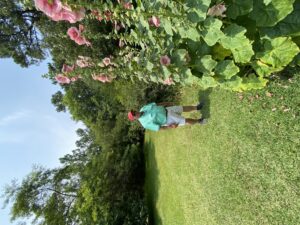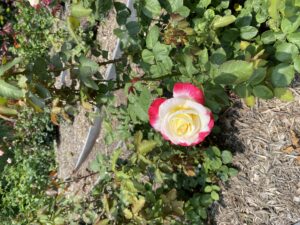Stanley Oliver – Local Rosarian
go.ncsu.edu/readext?943808
en Español / em Português
El inglés es el idioma de control de esta página. En la medida en que haya algún conflicto entre la traducción al inglés y la traducción, el inglés prevalece.
Al hacer clic en el enlace de traducción se activa un servicio de traducción gratuito para convertir la página al español. Al igual que con cualquier traducción por Internet, la conversión no es sensible al contexto y puede que no traduzca el texto en su significado original. NC State Extension no garantiza la exactitud del texto traducido. Por favor, tenga en cuenta que algunas aplicaciones y/o servicios pueden no funcionar como se espera cuando se traducen.
Português
Inglês é o idioma de controle desta página. Na medida que haja algum conflito entre o texto original em Inglês e a tradução, o Inglês prevalece.
Ao clicar no link de tradução, um serviço gratuito de tradução será ativado para converter a página para o Português. Como em qualquer tradução pela internet, a conversão não é sensivel ao contexto e pode não ocorrer a tradução para o significado orginal. O serviço de Extensão da Carolina do Norte (NC State Extension) não garante a exatidão do texto traduzido. Por favor, observe que algumas funções ou serviços podem não funcionar como esperado após a tradução.
English
English is the controlling language of this page. To the extent there is any conflict between the English text and the translation, English controls.
Clicking on the translation link activates a free translation service to convert the page to Spanish. As with any Internet translation, the conversion is not context-sensitive and may not translate the text to its original meaning. NC State Extension does not guarantee the accuracy of the translated text. Please note that some applications and/or services may not function as expected when translated.
Collapse ▲Everything’s coming up roses on the north end of Roanoke Island. Well, at least that’s the situation at the home of local rosarian, Stanley Oliver. Stanley has taken on our cactus and sandspur-loving-sandy soil and made it hospitable to the “Queen of Flowers”, the rose.
A blue sky above and a gentle breeze beckons one to stroll along the meandering paths through Stanley’s collection of hybrid tea roses, where the heavenly perfume of the Double Delight welcomes visitors with its stunning display of abundant creamy petals tinged in red. It’s Stanley’s favorite. “You just can’t beat the beauty and fragrance of that one.” he says. “It will fill up a room with its scent.” Gaze upon the classic deep red, velvety blooms of Mister Lincoln and take in the dazzling yellow and orange petals of Wildfire. “The best showing or cutting rose is Black Magic,” says Stanley, “with its large stem and black-red bloom.” The John F. Kennedy boasts up to 50 white petals with a distinctive licorice aroma. Adding to this floral parade of elegance and fragrance at bloom time will be the coral-pink and cream of Gemini, the yellow and pink-edged Bella’roma, and Fragrant Cloud with plush petals and a pungent scent of cloves. Stanley points out two David Austin English shrub roses as well: Munstead Wood which bears velvety crimson blooms enveloped in an “old rose” fragrance and Grace’s apricot-colored rosettes.
Stanley is an alumnus of NC State University with a degree in Agronomy (the study of soil and crop science). Upon graduating, he began working at an agricultural products and seed company in West Columbia, SC, where his supervisor brought in cut roses from his garden to share with the office staff. Impressed with the beauty of the flowers, Stanley was inspired to try his hand at cultivating roses himself.
Stanley’s career kept him on the move, living in various states and cities. With each relocation, he undertook establishing a rose garden. “I’ve always tried to keep a nice yard,” he says. And he has fond memories of his mother’s love of growing flowers. Along his rose-growing journey, he picked up tips from fellow rosarians but for the most part he learned on his own, through trial and error. “Every place I’ve lived, the soil is different, the insects are different,” he says. He recalls the rich, well-draining soil in Unionville, Pennsylvania, and the cool night temperatures there that led to very colorful flowers. “Here, on Roanoke Island, the soil is basically sand and requires lots of water and fertilization,” he says. “Flowers in the summer are not as vibrant as the ones in spring because the heat causes the colors to fade.”
Hybrid tea roses are the product of a cross between hybrid perpetual roses and old-fashioned tea roses. They have long, sturdy stems and pointed buds that open by slowly unfurling. Hybrid tea roses generally produce only one long-lasting blossom at the end of each stem rather than clusters of flowers and are ideal for cutting. “With hybrid teas, once they bloom, you cut them, and they bloom again in a month,” says Stanley.
Hybrid tea rose varieties are prone to diseases and insects. “Because of the high humidity in our area, roses are susceptible to black spot, powdery mildew, and downy mildew,” says Stanley. He recommends spraying every two weeks. “Don’t let the disease get out of hand.” The pests that typically present a problem for roses are aphids, spider mites, Japanese beetles, and thrips. “Spray beetles as soon as possible,” he says.
And, of course, when using pesticide and fungicide, follow the directions and wear proper safety equipment.
Stanley purchases bare-root roses from a popular mail-order catalog. They arrive, roots stripped of soil, packed in peat moss, bark, or other mixture and sealed in plastic to retain moisture during shipping. “Just as with anything, if you start out doing it right, your success is much greater,” says Stanley. “You cannot just throw a rose bush in the ground and hope for the best,” he says. Scout out a location that will offer 6 – 8 hours of sunlight. He recommends when digging the hole for the rose bush, that it be dug twice the size of what is needed – big and wide enough to fit the entire root system. “Fill the hole with cow manure, peat moss, and bone meal and then plant the rosebush. Most importantly,” he says, “when you plant a rose bush, wait 30 – 60 days before adding fertilizer, otherwise, the fertilizer will kill it. The roses have plenty of nutrients in the stems to get started and put out new roots.” Spread mulch around the newly-planted rose bush to help retain moisture and water it frequently.
In the growing season, Stanley spends about an hour every other day tending to the roses – ensuring they are properly watered, which he does by hand to avoid getting water on the leaves as it may encourage and spread disease. He thoroughly checks each plant for early signs of disease. “Hybrid teas should be cut back in the spring – but not too early or a late frost could ruin them,” he says.
Roses are often thought to be persnickety and a challenge to grow, causing gardeners to shy away from planting them. However, in recent years, roses have been bred and cultivated to be easier for gardeners to manage. “Understanding nature and gardening presents you with a challenge to solve problems and it’s exhilarating when you do it right,” Stanley says. His diligence in caring properly for his roses has resulted in healthy, thriving, beautiful plants. And yet there’s still time left in his day to pursue other interests, such as heading out on his boat in the Croatan Sound to cast a line for trout.
 Stanley’s roses are a showstopper, but he’s not a one-hit wonder. His green thumb is on full display across his entire yard. Sharing space with the roses are dahlias with multi-layered peach-colored petals, tall spikes of hollyhocks, cheery sunflowers, and vibrant zinnias. There are figs, kiwis, and pomegranates. And summer veggies – tomatoes, zucchini, squash, bell peppers, and asparagus. Adjacent to the lush garden, a swing hangs in the shade of a mighty oak tree, inviting one to sit a spell, breathe in the sweet perfume of nearby gardenias, and delight in the fluttering butterflies, darting hummingbirds, and buzzing bees.
Stanley’s roses are a showstopper, but he’s not a one-hit wonder. His green thumb is on full display across his entire yard. Sharing space with the roses are dahlias with multi-layered peach-colored petals, tall spikes of hollyhocks, cheery sunflowers, and vibrant zinnias. There are figs, kiwis, and pomegranates. And summer veggies – tomatoes, zucchini, squash, bell peppers, and asparagus. Adjacent to the lush garden, a swing hangs in the shade of a mighty oak tree, inviting one to sit a spell, breathe in the sweet perfume of nearby gardenias, and delight in the fluttering butterflies, darting hummingbirds, and buzzing bees.
 Stanley’s devotion to nurturing his enchanting variety of roses and other plants is a pleasurable task that he finds rewarding. But there’s more to the story. Stanley has what his wife, Paula, refers to as a “rose and flower ministry.” His love of growing roses has blossomed into a desire to share them with widows, or anyone who could benefit from a bit of cheering up. He thoughtfully creates a bouquet of his finest roses interspersed with other flowers, resulting in an exquisite arrangement that will soon find its way into the homes and hearts of widows in the community, providing a measure of comfort and joy, a gesture that lets them know they have not been forgotten. Delivering about twenty bouquets a year, he says, “There’s always someone who needs one.” Recently, five of the recipients have been ladies who are over 90 years old. “When you live to be 90 years old, you deserve a bouquet of roses!” he says.
Stanley’s devotion to nurturing his enchanting variety of roses and other plants is a pleasurable task that he finds rewarding. But there’s more to the story. Stanley has what his wife, Paula, refers to as a “rose and flower ministry.” His love of growing roses has blossomed into a desire to share them with widows, or anyone who could benefit from a bit of cheering up. He thoughtfully creates a bouquet of his finest roses interspersed with other flowers, resulting in an exquisite arrangement that will soon find its way into the homes and hearts of widows in the community, providing a measure of comfort and joy, a gesture that lets them know they have not been forgotten. Delivering about twenty bouquets a year, he says, “There’s always someone who needs one.” Recently, five of the recipients have been ladies who are over 90 years old. “When you live to be 90 years old, you deserve a bouquet of roses!” he says.
Roses have long been a symbol of love, hope, and joy, and are worthy of the title, “Queen of Flowers.” Indeed, few flowering plants can match their beauty. A beauty much like the smiles on the faces of those who receive one of Stanley’s heartfelt bouquets.






